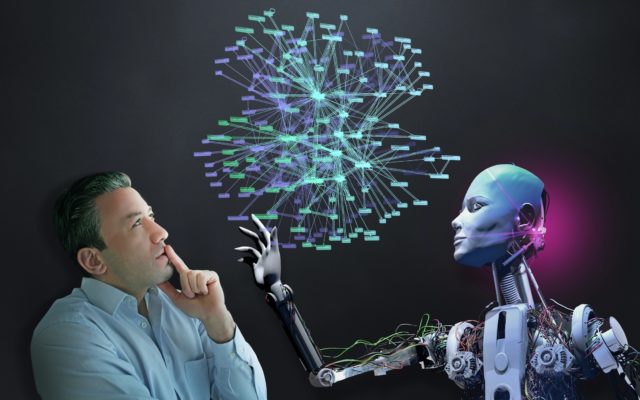With the amount of data being generated these days, trying to make sense of it all is like trying to find a needle in a haystack…while blindfolded…and with your hands tied behind your back.
That’s why the importance of AI is rapidly increasing in our modern society. The ability to process and analyze large amounts of data quickly and accurately in real-time is why we build AI systems. With the amount of data being generated in today’s digital world, it’s becoming increasingly difficult for humans to make sense of it all.
Let’s face it: Humans can’t handle the monotony of certain tasks.
Sure, folding laundry is therapeutic for some, but for the rest of us, we’d prefer a robot do it for us. With the rise of AI systems, automating such repetitive tasks is finally possible and it’s not just some Rosse-the-AI-maid Sci-Fi novel anymore!
What’s more, AI systems learn and adapt over time, improving their performance without human intervention. This is basically what a machine learning algorithm is: the chemical X of many AI systems. With the ability to learn and adapt, AI systems can predict and make increasingly accurate decisions.
Think of AI systems as the Energizer bunnies of technology. They just keep going and going while never ceasing learning. With their ability to adapt and improve over time, they become more and more efficient, making predictions and decisions that are almost always right.
Of course, when you have a computer system that adapts easily and creates efficient decision-making, wouldn’t that concern its creators? That’s why it’s important to understand the why and the how of developing AI systems.
Table of Contents
How to develop AI systems — a complete how-to guide with key steps
Before building an AI system, you have to figure out what problem it’s supposed to solve.
Let me tell you, some of these problems are real head-scratchers. Like, “How do we make a machine that can accurately predict if a cat video will go viral on the internet?” or “How do we make sure a self-driving car doesn’t drive straight into a passing cyclist on its first joyride?“.
Taking the complex questions at bay, these are the key steps on how to develop an AI system:
- Define the problem.
- Gather data.
- Clean and process data.
- Train the AI algorithm.
- Evaluate and deploy the system.
Defining the problem
“If you can’t define the problem, solving it is impossible” — probably some Stoic philosopher.
Defining involves understanding the goals and objectives of the system, as well as its constraints and limitations. For example, if you’re developing a self-driving car, the problem is defined as safe and efficient navigation on the roads while avoiding obstacles.
Understanding the context in which the system will operate, identifying the objectives, and breaking down the problem are the master ingredients in tackling this first step. Knowing the industry, the users, and any relevant regulations or laws while having specific, measurable, and achievable objectives lets you see the light at the end of the tunnel. By dealing with smaller pieces, this boogeyman problem becomes more manageable.
Plus, those little sub-problems help you to identify potential areas where the AI system adds more value.
Gathering data
Gathering data is one of the most time-consuming and challenging steps in the AI development process! There’s a simple explanation for that: There’s no data shortage in this world. It’s like trying to drink all the water coming out from a fire hose – there’s too much of it and it never stops!
Sensor data from cars, images from cameras, or text from social media are all valuable assets used to train and test AI systems. The quality and quantity of data available impacts significantly the system’s performance. So the data must be accurate, diverse, and representative of the problem you’re solving.
Data cleaning and processing
This is a MUST-DO part when building an AI system.
Data cleaning is all about identifying and removing errors, inconsistencies, or outliers in the data. It includes things like getting rid of missing values, duplicated data, or irrelevant information. Data processing is the process of preparing the data for use in the AI system. Normalizing the data and converting it into an AI-friendly format is a part of this process.
It’s like trying to organize your grandma’s Tupperware collection. It’s a daunting task, but someone has to do it.
Training the AI algorithm
There are different AI algorithms available to choose from, each with its own strengths and weaknesses.
The most popular algorithms include decision trees, neural networks, and deep learning. The choice of algorithm depends on the problem you’re solving, the type of data available, and the desired level of performance. It isn’t a one-glove-fits-all thing. Training the AI algorithm involves feeding it large amounts of clean data and adjusting the parts of the algorithm until it accurately predicts or classifies said data.
It’s like trying to pick a favorite child. But don’t worry, you’ll figure it out eventually. P.S. I’ll tell you a secret. My favorite type of AI algorithm is decision trees, but don’t tell anybody.
Evaluation and system deployment
Finally, the moment arrives!
Testing the system on fresh, unseen data tells a perfect tale of its performance. Accuracy, precision, and recall are the metrics for evaluating the system. If it performs well on the test data, the next step is deployment in the real world. But don’t forget that every piece of software, even AI, needs careful maintenance and revision.
It’s like sending your kid off to college. It’s equally terrifying and exhilarating. Will they make friends? Will they do well in their classes? Will they become the next tech billionaire?
Only time will tell.








